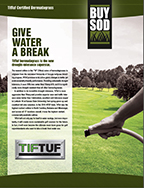As a turfgrass manager, you know that heavy rainfall can be a double-edged sword. While it provides much-needed hydration for your turf, excessive water can lead to overwatering, which can be detrimental to the health of your grass. In this blog post, we’ll discuss four expert tips to help you mitigate the risks of overwatering and ensure your turf remains healthy and vibrant.
Mitigating Overwatering Risks Amid Heavy Rainfall

- Monitor Soil Moisture Levels: Invest in a soil moisture meter to accurately measure the moisture content of your turf. This will help you determine whether your turf is receiving enough water from rainfall or if additional watering is necessary.
- Adjust Irrigation Schedule: During periods of heavy rainfall, it’s important to adjust your irrigation schedule to prevent overwatering. Consider installing a rain sensor that automatically shuts off your irrigation system when it detects rainfall.

- Improve Drainage: Ensure that your turf has proper drainage to prevent water from pooling and saturating the soil. Aerating your turf can help improve drainage and prevent overwatering.
- Use Drought-Tolerant Grass Varieties: Consider planting drought-tolerant grass varieties that require less water and are more resilient to heavy rainfall. These grasses can help reduce the risk of overwatering and promote a healthier turf.
By following these expert tips, you can effectively manage your turfgrass during periods of heavy rainfall and prevent the risks associated with overwatering. Implementing these strategies will not only help you maintain a healthy and vibrant turf but also save you time and resources in the long run.

